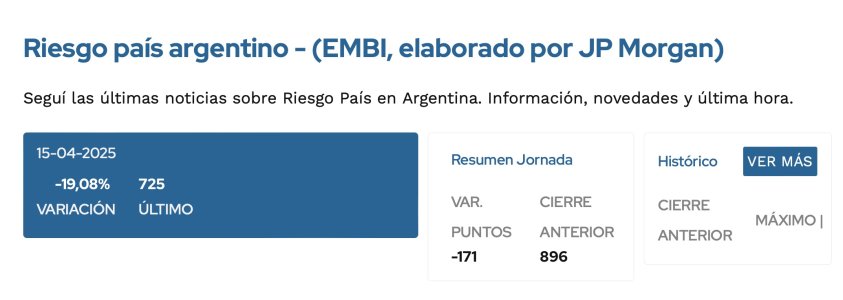earlyretirement
Moderator
Argentina's country risk (Riesgo Pais) has seen a significant improvement, breaking through the 600-point threshold and approaching the Latin American average of 406 basis points as of January 7, 2025.
This development marks a substantial positive shift in Argentina's economic outlook and financial standing on the global stage
.The country risk index, calculated by JP Morgan, has been steadily falling due to rising optimism in Argentine financial markets. This decline coincides with several positive economic indicators:Fiscal Performance: Argentina ran a fiscal surplus for the first time in many years between January and September 2024.
Inflation Control: Monthly inflation decreased from a peak of 25.5% in December 2023 to 4.2% in August 2024.
Bond Performance: Dollar-denominated bonds have seen daily increases of up to 1.8%.The dramatic reduction in country risk opens up significant opportunities for both the government and companies. Access to International Debt Markets: With the risk index approaching the Latin American average, Argentina is now in a much better position to access international credit markets.
Lower Borrowing Costs: The decreased risk perception should translate into lower interest rates for Argentine bonds, reducing the cost of borrowing for both the government and private sector.
Increased Foreign Investment: Improved risk ratings typically attract more foreign direct investment, which could boost economic growth and job creation.
This development marks a substantial positive shift in Argentina's economic outlook and financial standing on the global stage
.The country risk index, calculated by JP Morgan, has been steadily falling due to rising optimism in Argentine financial markets. This decline coincides with several positive economic indicators:Fiscal Performance: Argentina ran a fiscal surplus for the first time in many years between January and September 2024.
Inflation Control: Monthly inflation decreased from a peak of 25.5% in December 2023 to 4.2% in August 2024.
Bond Performance: Dollar-denominated bonds have seen daily increases of up to 1.8%.The dramatic reduction in country risk opens up significant opportunities for both the government and companies. Access to International Debt Markets: With the risk index approaching the Latin American average, Argentina is now in a much better position to access international credit markets.
Lower Borrowing Costs: The decreased risk perception should translate into lower interest rates for Argentine bonds, reducing the cost of borrowing for both the government and private sector.
Increased Foreign Investment: Improved risk ratings typically attract more foreign direct investment, which could boost economic growth and job creation.



